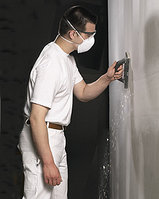
| Whether you’ve hired a professional to complete your drywall installation or are a do-it-yourselfer, the mess that comes along with this type of project is inevitable. But it doesn’t have to be as bad as you think. There are several steps that can be taken to reduce the dust that results from installing drywall, so you’re not still cleaning up for weeks after the project is completed. |
| First, mark where the construction zone begins and ends so that the mess doesn’t migrate into the rest of the home. Put up plastic sheeting in doorways or over vents in the area where you will be working. Move whatever belongings out of the room that you can, or drape them with cloths. Also cover the floors in and leading to and from your renovation area with drop cloths. Use plastic or heavy drop cloths, and tape them down if necessary. Cut your drywall and any other lumber and trim outside, or in the garage if it’s winter. This keeps as much mess as possible out of the home. You can also mix your joint compound outside. Sanding the joint compound, also known as the “mud” that fills the gaps between the drywall, creates dust. A growing number of DIYers, contractors and remodelers are eliminating this cloud of dust by using a new product called SHEETROCK® brand dust control joint compound from USG, the same company that makes SHEETROCK gypsum panels. This innovative compound goes on like regular joint compound, but binds up fine residue during sanding to form particles that fall straight to the floor in a heavy dust instead of clouding the air. As a result, the work goes quicker and cleans up faster. When sanding the drywall mud, use an open-screen sandpaper so that the dust does not build up in the grit like it does with regular sandpaper, but instead falls out of the screen. If your mud is already smooth, you also may wet sand it with a sponge instead of dry sanding. Make sure to clean the sponge frequently. After applying tape to the wall over the joint compound, clean up any bits of tape that may have fallen on the floor during the job. Vacuum or sweep the construction area at the end of each day to control the mess. This keeps dust from being tracked into other areas of the house, or from circulating in the air. By following these tips, you can have a cleaner house during your next drywall project and lessen the disruption to your everyday life during renovation. |










